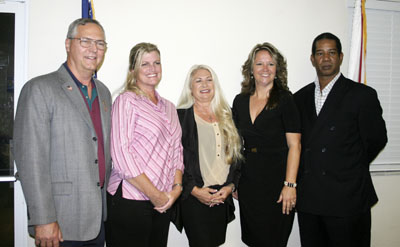The Indian Trail Improvement District Board of Supervisors gave the go-ahead last week for its staff to continue negotiations with the South Florida Water Management District and the Florida Fish & Wildlife Conservation Commission on an agreement to use the 2,300-acre Moss property as a stormwater outfall area that could significantly improve ITID’s drainage capacity.
Supervisor Gary Dunkley, who ran for the board on a platform of improving drainage after he was stuck in his home for 10 days during flooding from Tropical Storm Isaac, worked with several different officials to get an agreement started.
After hearing a report from ITID Engineer Jay Foy at a recent board meeting, Dunkley said he met with representatives from the SFWMD, as well as environmentalists Drew Martin of the Sierra Club and Martha Musgrove of the Florida Wildlife Federation, who liked the idea of taking water from ITID to rehydrate the Moss property.
Dunkley then met with elected officials, including state representatives Mark Pafford (D-District 86) and Pat Rooney (R-District 85), and County Commissioner Jess Santamaria. Acreage activist Alan Ballweg also attended the meetings.
Foy said the roughly triangular 2,300-acre Moss property is a drainage easement located at the southwest corner of the J.W. Corbett Wildlife Management Area, but neither the Florida Fish & Wildlife Conservation Commission, which owns both Corbett and Moss, or the SFWMD, have legal access to the Moss property and need a permit from ITID.
“There’s a whole bunch of legislative and administrative issues to get there, but the basic premise is environmentalists need the water and we have the water,” Foy said. “Since we have the pumps, we could easily supply them with the amount of water that they need.”
Ballweg said Dunkley has been working for months on the proposal, which culminated in a trip to Tallahassee last month to meet with the Acquisition & Restoration Council, a 10-member group made up of appointees from several state agencies, including the Florida Fish & Wildlife Conservation Commission, which reviews proposals for the use of state-owned conservation lands.
“This project is good not only for Indian Trail but also for the environment, converting 2,300 acres of over-drained former farmland into wetland, which will recharge the aquifer, provide habitat for birds and wildlife, as well as recreational hunting and fishing opportunities,” Ballweg said. “The Moss property has the potential to change us from being drainage-poor to being drainage self-sufficient. This is probably the best drainage news in decades. It will provide a significant benefit to the health, safety and welfare of the residents, and I encourage the board to enthusiastically support this project.”
Dunkley said the project could take as long as 15 years to complete, but asked the board to give ITID staff approval to work on a temporary pump station for emergencies.
Foy said that ITID has historically worked with the SFWMD and Palm Beach County on the North County Drainage Plan, including drainage to the L-8 Canal as part of the Loxahatchee River Restoration Project, and that the environmental lift of the Moss property is part of that plan.
“The whole basis for support was restoration of the Moss property,” Foy said. “There’s a lot of legal issues with flowage easement, but basically the county is giving 150 acres [at Mecca Farms] for a gun range to the FWC. Part of the reimbursement is the Corbett property and the other part would be in this flowage easement.”
Foy said the temporary pump could be in place in the next few years, rather than wait as long as 15 years for a final agreement.
“As soon as the legal and administrative issues are straightened out by around June, we would love to approach the South Florida Water Management District for a permit for a temporary pump,” Foy said.
ITID Attorney Ruth Clements said she has been working with the SFWMD on flowage easements on Corbett and Moss, which could be finalized by May or June.
Clements added that she met with SFWMD officials last week, and they are compiling a list of requirements that would have to be met with the involved agencies.
“One of the things they told us, and I was really kind of surprised they told us, was that they do not have access to Moss,” Clements said. “Fish & Wildlife also does not have legal access to Moss. We can provide that legal access. That’s what they’re trying to get from us.”
Foy asked for a consensus of the board to move ahead on discussions, and Dunkley made a motion for the board to support the Moss property rehydration project, which carried unanimously.
Dunkley made another motion for the board to direct staff to continue its work on the project and to report back to the board regularly, which also carried unanimously.
“We have an opening,” Dunkley said. “We don’t have to beg anybody for getting rid of the water, but I want staff to do it correctly.”
ABOVE: The Indian Trail Improvement District Board of Supervisors.








